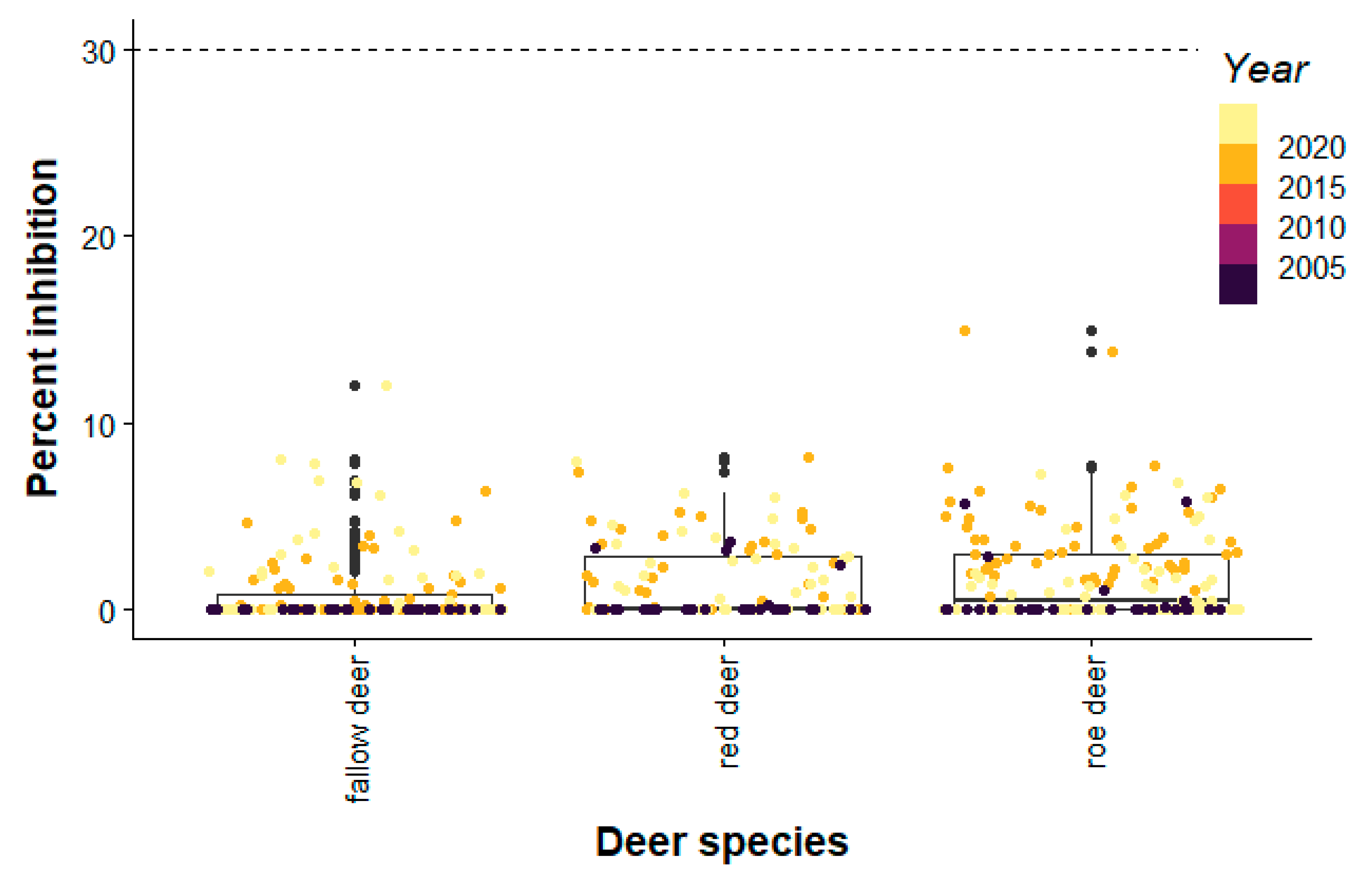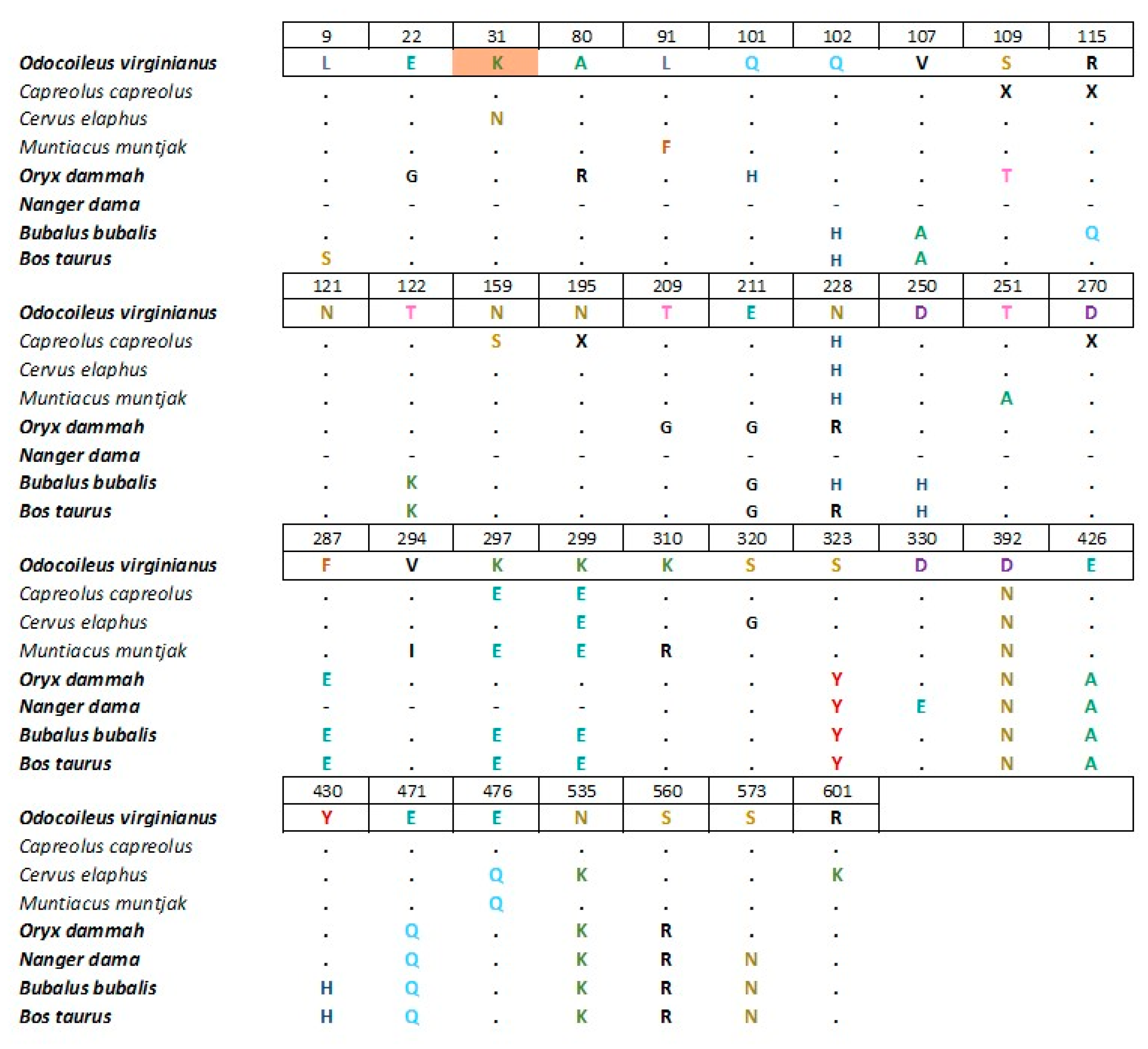Serological Evidence That SARS-CoV-2 Has Not Emerged in Deer in Germany or Austria during the COVID-19 Pandemic
Abstract
:1. Introduction
2. Materials and Methods
3. Results
4. Discussion
Supplementary Materials
Author Contributions
Funding
Institutional Review Board Statement
Data Availability Statement
Acknowledgments
Conflicts of Interest
References
- Hale, V.L.; Dennis, P.M.; McBride, D.S.; Nolting, J.M.; Madden, C.; Huey, D.; Ehrlich, M.; Grieser, J.; Winston, J.; Lombardi, D.; et al. SARS-CoV-2 Infection in Free-Ranging White-Tailed Deer. Nature 2021, 602, 481–486. [Google Scholar] [CrossRef] [PubMed]
- Chandler, J.C.; Bevins, S.N.; Ellis, J.W.; Linder, T.J.; Tell, R.M.; Jenkins-Moore, M.; Root, J.J.; Lenoch, J.B.; Robbe-Austerman, S.; DeLiberto, T.J.; et al. SARS-CoV-2 Exposure in Wild White-Tailed Deer (Odocoileus virginianus). Proc. Natl. Acad. Sci. USA 2021, 118, e2114828118. [Google Scholar] [CrossRef] [PubMed]
- Kuchipudi, S.V.; Surendran-Nair, M.; Ruden, R.M.; Yon, M.; Nissly, R.H.; Vandegrift, K.J.; Nelli, R.K.; Li, L.; Jayarao, B.M.; Maranas, C.D.; et al. Multiple Spillovers from Humans and Onward Transmission of SARS-CoV-2 in White-Tailed Deer. Proc. Natl. Acad. Sci. USA 2022, 119, e2121644119. [Google Scholar] [CrossRef]
- Oreshkova, N.; Molenaar, R.J.; Vreman, S.; Harders, F.; Oude Munnink, B.B.; Hakze-van der Honing, R.W. SARS-CoV-2 Infection in Farmed Minks, The Netherlands, 2020. Eurosurveillance 2020, 25, 2001005. [Google Scholar] [CrossRef]
- Oude Munnink, B.B.; Sikkema, R.S.; Nieuwenhuijse, D.F.; Molenaar, R.J.; Munger, E.; Molenkamp, R. Transmission of SARS-CoV-2 on Mink Farms between Humans and Mink and Back to Humans. Science 2021, 371, 172–179. [Google Scholar] [CrossRef] [PubMed]
- Jo, W.K.; Ferreira de Oliveira-Filho, E.; Rasche, A.; Greenwood, A.D.; Osterrieder, K.; Drexler, J.F. Potential Zoonotic Sources of SARS-CoV-2 Infections. Transbound. Emerg. Dis. 2021, 68, 1824–1834. [Google Scholar] [CrossRef] [PubMed]
- Damas, J.; Hughes, G.M.; Keough, K.C.; Painter, C.A.; Persky, N.S.; Corbo, M.; Hiller, M.; Koepfli, K.-P.; Pfenning, A.R.; Zhao, H.; et al. Broad Host Range of SARS-CoV-2 Predicted by Comparative and Structural Analysis of ACE2 in Vertebrates. Proc. Natl. Acad. Sci. USA 2020, 117, 22311–22322. [Google Scholar] [CrossRef] [PubMed]
- Tan, C.W.; Chia, W.N.; Qin, X.; Liu, P.; Chen, M.I.; Tiu, C. A SARS-CoV-2 Surrogate Virus Neutralization Test Based on Antibody-Mediated Blockage of ACE2-Spike Protein-Protein Interaction. Nat. Biotechnol. 2020, 38, 1073–1081. [Google Scholar] [CrossRef] [PubMed]
- Perera, R.A.P.M.; Ko, R.; Tsang, O.T.Y.; Hui, D.S.C.; Kwan, M.Y.M.; Brackman, C.J. Evaluation of a SARS-CoV-2 Surrogate Virus Neutralization Test for Detection of Antibody in Human, Canine, Cat, and Hamster Sera. J. Clin. Microbiol. 2021, 59, e02504-20. [Google Scholar] [CrossRef] [PubMed]
- Oliveira-Filho, E.F.; Carvalho, O.V.; Carneiro, I.O.; D’ambroso Fernandes, F.; Vaz, S.N.; Pedroso, C.; Gonzalez-Auza, L.; Urbieta, V.C.; Kühne, A.; Mayoral, R.; et al. Frequent Infection of Cats with SARS-CoV-2 Irrespective of Pre-Existing Enzootic Coronavirus Immunity, Brazil 2020. Front. Immunol. 2022. [Google Scholar] [CrossRef]
- Putman, R. A review of the various legal and administrative systems governing management of large herbivores in Europe. In Ungulate Management in Europe: Problems and Practices; Putman, R., Apollonio, R., Andersen, R., Eds.; Cambridge University Press: Cambridge, UK, 2011; pp. 54–79. [Google Scholar]
- Organ, J.F.; Geist, V.; Mahoney, S.P.; Williams, S.; Krausman, P.R.; Batcheller, G.R.; Decker, T.A.; Charmichael, R.; Nanjappa, P.; Regan, R.; et al. The North American Model of WildLife Conservation. In The Wildlife Society Technical Review 12-04; The Wildlife Society: Bethesda, MA, USA, 2012. [Google Scholar]
- Kahlen, J.; Svadlenak-Gomez, K.; Walzer, C. ALPBIONET 2030: Wildlife Management within the EUSALP Perimeter. 2019. Available online: https://www.alpine-space.org/projects/alpbionet2030/wpt2/d.t2.1.1-d.t2.3.1_wildlife-management-within-the-eusalp-perimeter.pdf (accessed on 28 March 2022).
- Milner, J.M.; Van Beest, F.M.; Schmidt, K.T.; Brook, R.K.; Storaas, T. To Feed or Not to Feed? Evidence of the Intended and Unintended Efects of Feeding Wild Ungulates. J. Wildl. Manag. 2014, 78, 1322–1334. [Google Scholar] [CrossRef] [Green Version]
- Grund, M.; McAninch, J.; Wiggers, E. Seasonal Movements and Habitat Use of Female White-Tailed Deer Associated with an Urban Park. J Wildl. Manag. 2002, 66, 123–130. [Google Scholar] [CrossRef]
- Reaser, J.K.; Hunt, B.E.; Ruiz-Aravena, M.; Tabor, G.M.; Patz, J.A.; Becker, D.J.; Locke, H.; Hudson, P.J.; Plowright, R.K. Fostering Landscape Immunity to Protect Human Health: A Science-Based Rationale for Shifting Conservation Policy Paradigms. Conserv. Lett. 2022. [Google Scholar] [CrossRef]


| Germany | Austria | ||
|---|---|---|---|
| Pre-Pandemic | Pandemic | Pandemic | |
| Roe deer | 71 | 97 | |
| Red deer | 45 | 16 | 51 |
| Fallow deer | 85 | 68 | |
| Total | 201 | 181 | 51 |
Publisher’s Note: MDPI stays neutral with regard to jurisdictional claims in published maps and institutional affiliations. |
© 2022 by the authors. Licensee MDPI, Basel, Switzerland. This article is an open access article distributed under the terms and conditions of the Creative Commons Attribution (CC BY) license (https://creativecommons.org/licenses/by/4.0/).
Share and Cite
Moreira-Soto, A.; Walzer, C.; Czirják, G.Á.; Richter, M.H.; Marino, S.F.; Posautz, A.; De Yebra Rodo, P.; McEwen, G.K.; Drexler, J.F.; Greenwood, A.D. Serological Evidence That SARS-CoV-2 Has Not Emerged in Deer in Germany or Austria during the COVID-19 Pandemic. Microorganisms 2022, 10, 748. https://doi.org/10.3390/microorganisms10040748
Moreira-Soto A, Walzer C, Czirják GÁ, Richter MH, Marino SF, Posautz A, De Yebra Rodo P, McEwen GK, Drexler JF, Greenwood AD. Serological Evidence That SARS-CoV-2 Has Not Emerged in Deer in Germany or Austria during the COVID-19 Pandemic. Microorganisms. 2022; 10(4):748. https://doi.org/10.3390/microorganisms10040748
Chicago/Turabian StyleMoreira-Soto, Andres, Christian Walzer, Gábor Á. Czirják, Martin H. Richter, Stephen F. Marino, Annika Posautz, Pau De Yebra Rodo, Gayle K. McEwen, Jan Felix Drexler, and Alex D. Greenwood. 2022. "Serological Evidence That SARS-CoV-2 Has Not Emerged in Deer in Germany or Austria during the COVID-19 Pandemic" Microorganisms 10, no. 4: 748. https://doi.org/10.3390/microorganisms10040748
APA StyleMoreira-Soto, A., Walzer, C., Czirják, G. Á., Richter, M. H., Marino, S. F., Posautz, A., De Yebra Rodo, P., McEwen, G. K., Drexler, J. F., & Greenwood, A. D. (2022). Serological Evidence That SARS-CoV-2 Has Not Emerged in Deer in Germany or Austria during the COVID-19 Pandemic. Microorganisms, 10(4), 748. https://doi.org/10.3390/microorganisms10040748









